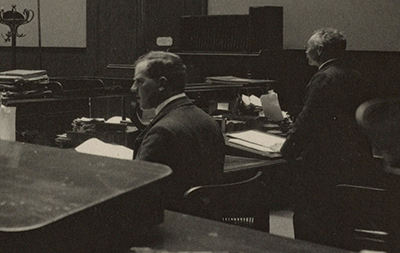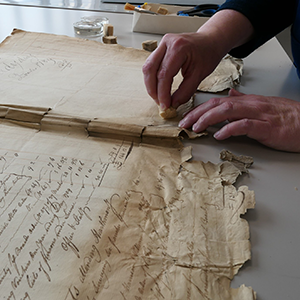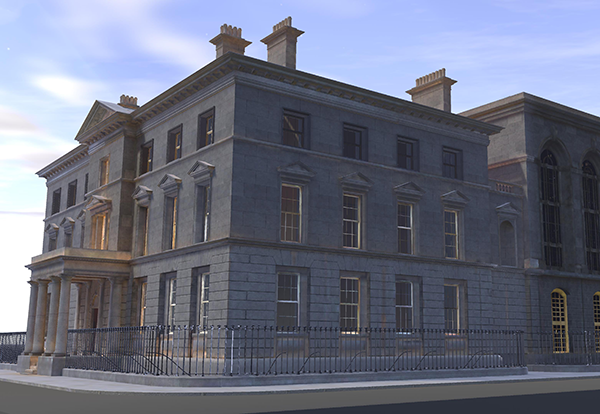THE VIRTUAL RECORD TREASURY OF IRELAND: A CENTURY OF RECOVERY FROM THE 1922 FOUR COURTS BLAZE—AND BEYOND
Published in Features, Issue 3 (May/June 2022), Volume 30By Peter Crooks, Zoë Reid and Ciarán Wallace
In this, the third of three articles counting down to the centenary of the Four Courts fire in June 2022, the authors examine the aftermath of the blaze and the work of Beyond 2022 as an all-island and international partnership to reconstruct what was lost 100 years ago.
‘The tragedy of 1922 lies in the fact that the method of assembling the public records under one roof was the very means of making such a destruction possible’
—Herbert Wood, Deputy Keeper of the Public Records in Ireland.
Herbert Wood is famous as the author of the volume once called the most depressing book in Irish history: the Guide to the contents of the Public Record Office of Ireland (PROI), published in 1919.
Wood first joined the PROI at the age of 23, having relocated to Ireland in 1884 following a degree in divinity and classics at Oxford. When he arrived in Dublin the PROI was still a fledgling institution. It opened to the public in 1867 under its first deputy keeper, Sir Samuel Ferguson, who remained at the helm until his death in 1886. In the year that Wood joined the PROI staff, the purpose-built repository known as the ‘Record Treasury’ was only two-thirds full. Ferguson’s annual report of 1884 records that 40 bays of shelving lay vacant. More poignantly, Ferguson also noted in 1884 that wooden shelving throughout the Record Treasury had been replaced with galvanised steel as an ‘important precaution against fire’.
Wood spent the next 38 years rising through the ranks. By 1912—the year he became assistant deputy keeper (the second-highest position in the office hierarchy)—the Record Treasury had reached capacity. Finally, in 1921 he succeeded as deputy keeper on the retirement of Michael J. McEnery. Within a few months, Wood and his colleagues were ejected at Easter 1922 when anti-Treaty forces occupied the Four Courts. Ten weeks later, the Record Treasury was completely gutted by fire in the opening engagement of the Civil War (see HI 27.4, July/August 2019, pp 44–7).
‘NOT EASY NOW TO BE IMAGINED’

Above: Herbert Wood (left) and D.A. Chart (later the first deputy keeper of the PRONI) in the PROI Search Room in 1914. (NAI)
In mid-July 1922 Herbert Wood returned to the Four Courts to survey the damage. The PROI block on the western side of the complex lay in ruins. The entire Record Treasury had been consumed by the fire. The force of an explosion brought down its eastern arcade of windows. The ironwork galleries which held the records had buckled, casting the documents into the flames.
All was not lost. The Record House—the administration block at the southern end of the building, where the Search Room and Strong Room were located—survived the fire. Although the building was breached by artillery and damaged by bullets, the firebreak which separated the Record Treasury from the Record House prevented the flames from spreading into the administration building.
When Wood re-entered the Search Room where he had spent his entire career, he was confronted by a scene ‘not easy now to be imagined’ (55th Report of the Deputy Keeper of the Public Records):
‘The Search Room and other rooms on the ground floor were piled high with debris … Out of the debris were picked calendars and indexes, and fragments of calendars and indexes … The presence of explosive substances rendered the work of salvage dangerous and the reality of the danger was proved by a miniature explosion which took place sometime afterwards in the Strong Room.’
A photograph taken in early July 1922 (below) shows a National Army soldier standing in the ruined Search Room of the PROI, looking at munitions manufacturing equipment fitted to a table. The wide wheel to attach the machine to a motor using a drive belt is visible to the right side. National Army forces shelled the west (Church Street) side of the Record House, creating an opening through the external wall, the research library and the internal wall of the Search Room. Between the soldier and the table, the secure metal door to the Strong Room is visible. This is where records were temporarily stored each evening for readers intending to return the following morning.

Above: A National Army soldier in the ruined Search Room in July 1922 examines equipment used by the anti-Treaty defenders to make munitions. (NLI)
‘PASSED INTO OBLIVION’
Doubtless the first reaction upon entering the Record House must have been shock. ‘At one blow, the records of centuries have passed into oblivion’, wrote Wood. But the second impulse was to pick up the scattered fragments, to reassemble and rebind volumes of calendars and indexes—to restore order from chaos. John Chaloner Smith (1870–1932) was appointed as the salvage officer following an order on 4 July 1922 from Minister for Finance Michael Collins. Smith was a structural engineer, working for the Office of Public Works. On 13 July he began to assess the extent of the damage and manage the salvage operation.
In the months that followed, the staff systematically worked through the rubble to recover documents. Bundles of archives were taken for sorting to a room in the Record Tower of Dublin Castle, where staff cleaned the building debris off the documents and worked together to identify the material as accurately as possible. Carefully wrapped in brown paper, the records were secured with string with handwritten labels attached. This work of salvage and identification continued for almost a year.
TOWARDS THE CENTENARY AND BEYOND
The Virtual Record Treasury of Ireland is the outcome of a five-year State-funded programme of research entitled Beyond 2022. Its mission has been to re-imagine and recreate through virtual reality the PROI buildings and archival collections. In 2017–18 the National Archives of Ireland (successor institution to the PROI), the National Archives UK (successor institution to the Public Record Office, London, established in 1838) and the Public Record Office of Northern Ireland (PRONI, established in 1923–4) joined forces to create a research partnership with Trinity College, Dublin, and the Science Foundation Ireland ADAPT Centre for digital technologies. This marked the first formal partnership of these three genetically linked archival institutions. They were soon joined as core partners by the Irish Manuscripts Commission (established in 1928) and the Library of Trinity College, Dublin. By 2022 nearly 70 other archives, libraries and learned societies in Ireland, Britain and the United States have formally joined the enterprise to bring the destroyed Record Treasury back to life.
RESTOCKING THE SHELVES
The starting point for the research was Herbert Wood’s Guide of 1919. Far from being a depressing documentary mausoleum, Wood’s Guide is the key that unlocks the archival structure of the PROI’s collections. Most of the descriptions in Wood’s Guide are tantalisingly brief. Using other surviving office records from the era before 1922, it is often possible to expand on the Guide to generate fine-grained descriptions of the contents of each shelf in the Record Treasury.
Since 2017, with the support of the Irish Manuscripts Commission, the National Archives has undertaken a detailed conservation assessment and preliminary listing of the 1922 Salved Records. Conservation work by Jessica Baldwin, Project Conservator, is proceeding on documents from the early fourteenth century to 1922. The work involves surface cleaning of documents to reveal text obscured by dirt, as well as repair to torn and damaged pages to make them safe when handled by researchers. More complicated treatments involve the separation and reshaping of distorted parchment.
1766 RELIGIOUS CENSUS

Above: Surface-cleaning damaged paper using small ‘smoke’ sponge squares—Exchequer, Revenue Side, Collectors’ Accounts, 1798. (NAI)
The returns for the 1766 religious census of Ireland provide an excellent example of the possibilities of archival reconstruction. They are one of the richest sources available to the historical and genealogical researcher for the period prior to the commencement of the statutory census series in 1813.
Wood’s description of this important series amounts to six words and a date range—‘Returns of Protestants and Roman Catholics, 1764–1766’—but pre-1922 indexes to the material in the Parliamentary Record Office, which survived the fire, enabled Dr Brian Gurrin to reconstruct almost the entire archival hierarchy of nearly 800 census returns. The records also show their precise physical locations on the western side of the destroyed Record Treasury, where they occupied two shelves on the fifth floor in ‘Bay O’. The 1766 returns were arranged in bundles, each bundle containing the individual parish returns from two or more dioceses. By good fortune, 59 original items from the census survived the fire, covering parishes in Armagh, Cork, Derry, Limerick, Louth, Tipperary, Tyrone and Waterford. They were probably spared because they were held over in the Strong Room at Easter 1922. These salved returns have been conserved and digitised by the National Archives with support from the Irish Manuscripts Commission.
The 59 salved documents represent 7% of the original total. By combining these with all other transcriptions—for instance, handwritten and typed notes by the genealogist Tenison Groves which now survive in the National Library of Ireland, the PRONI and the Representative Church Body Library—more than 50% of the 1766 census can be reconstructed in whole or in part. Over 50,000 names of individuals across all religious denominations have been transcribed from these sources. This may be some compensation for the destruction of the individual returns from the nineteenth-century statutory census. Alas, for these only fragmentary replacements are possible.
DOCUMENTARY DIASPORA
The 1766 religious census provides one demonstration of the principle of archival reconstruction and the benefit of digitally interlinking archives. This is all the more important because Ireland’s historical collections have been scattered far and wide across the world. Another example of records reunited for the first time since 1867 are the Irish State papers from the seventeenth century known as the ‘Philadelphia Papers’. They include correspondence from the king to the lord deputy of Ireland concerning the plantation of Ulster.
In 1867—the year the PROI first opened its doors—the Library Company of Philadelphia sent five volumes of original State papers (1592–1643) in its custody back to Britain. These had been taken from Dublin Castle a century earlier. They were never returned to the Castle and found their way across the Atlantic to Philadelphia. After re-crossing the Atlantic in 1867, the original volumes were eventually returned to Dublin and deposited for safe keeping at the new Public Record Office of Ireland—only to be destroyed in 1922.
Fortunately, all five volumes were copied out in full. The duplicates were preserved by the Public Record Office, London. These copy volumes survive in the National Archives UK, where the title-page tells the whole story of how they were ‘restored to the British Nation’. A sixth original volume was never returned to Ireland and so was not destroyed in 1922. It is still held by the Library Company of Philadelphia. To mark the centenary, all six volumes—the sole remaining original in Philadelphia and the five duplicates preserved in London—have been digitised and can be reunited on screen.
REPLENISHING LOST MEMORIES
Shortly after visiting the burned-out PROI, Herbert Wood described the devastation visited upon Ireland’s records by ‘fire and flame, carelessness and pilfering’ over the centuries, culminating in 1922. ‘If the roots of the present lie in the past’, he meditated, ‘the attempt to re-create that past is not only laudable, it is an imperative necessity, if we are to understand the present. But how can that be done when the very material which is to be used for this purpose is consigned to the flames or carelessly allowed to perish?’
A century on, an answer to Wood’s rhetorical question lies in deepening archival collaborations and democratising access through technology to shared documentary heritage. Despite the losses sustained 100 years ago, Ireland is privileged, by global standards, to have a remarkably deep, rich and complex documentary heritage stretching back centuries. The custodianship of that archival heritage rests with dedicated librarians and archivists across the island and around the world. By connecting this material digitally through the Virtual Record Treasury, the rich and complex story of Ireland’s deep past can be recovered for everyone to explore—and we can begin to replenish our lost national memories.
Peter Crooks is Senior Lecturer in the Department of History, Trinity College, Dublin, and Director of Beyond 2022; Ciarán Wallace is Deputy Director; Zoë Reid is Keeper, Public Services and Collections, National Archives of Ireland.
Further reading
G. Beiner, ‘Forgetting 1922’, in D. Gannon & F. MGarry (eds), Ireland 1922: independence, partition, civil war (Royal Irish Academy, 2022), 335–9.
B. Gurrin, K.A. Miller & L. Kennedy, The Irish religious censuses of the 1760s: Catholics and Protestants in eighteenth-century Ireland (Dublin, 2022).
H. Wood, ‘The public records of Ireland before and after 1922’, Transactions of the Royal Historical Society (4th ser.) 13 (1930).

















